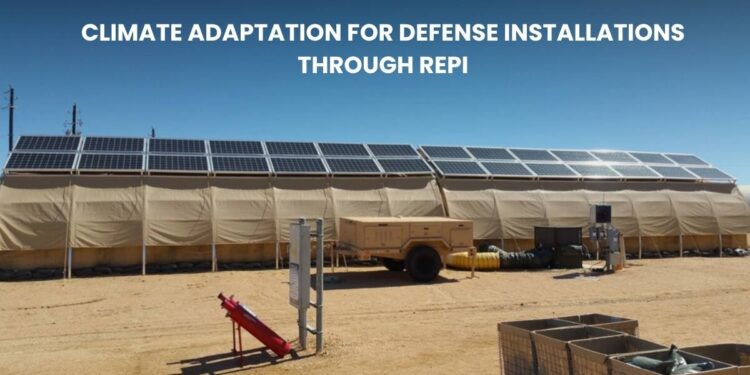The US Department of Defence has increased its focus on environmental and natural habitat protection during military installations, as a large number of lands are under its administration. The REPI program is one of the effective programs to achieve its goals, so let’s see how it helps.
The US DoD initiated the REPI program to support climate adaptation at military installations, as it provides funds to projects that address climate risks and work to protect and safeguard the ecosystem. Over the decade, extreme weather and climate change have affected the military readiness, infrastructure, training, and other aspects.
The Department knows that climate adaptation will help in the long run to deal with climate change and extreme weather. The DoD has released the Climate Adaptation Plan for 2024-27 and identified REPI as a major force.
How does REPI address the climate issues for defence installations?
The Readiness and Environmental Protection Integration (REPI) program was initiated in 2002 under the National Defense Authorization Act to preserve the military’s ability to execute missions, mitigate land-use conflicts, and oversee the environmental restrictions. Let’s explore how REPI does this and plays a crucial role in climate adaptation:
- REPI creates buffer zones around the defence installation to conserve the land and maintain the ability to preserve the operational capability in the changing climatic conditions.
- The program has a cost-sharing agreement between the military, federal agencies, state or local territories, and local communities to increase defense installation climate resilience and remove other issues.
- The program has three parts- encroachment, landscape partnerships, and stakeholder engagement to maintain the sustainability, provide solutions, and help in decision-making for defence installations.
- The program funds nature-based solutions, such as stormwater drainage basins, to manage flooding and heavy rainfall.
- The program analyzes the ecological, environmental, and other impacts and identifies projects that meet the community and military needs.
What are the REPI funding and results for climate adaptation?
The program has taken various efforts to strengthen the community partnership for enhancing climate adaptation, protecting the ecosystem, natural infrastructure near defence installations, and promoting natural resources management.
According to the REPI reports, the program has protected around 830,000 acres of land in 35 US states in 118 locations. The Defence Secretary has administered the projects and implemented the military services.
The funding for the REPI from Congress has increased over the years – 12.5 million in FY 2025, $105 million in FY 2021. The REPI projects are proven to be cost-effective, as partner contributions made it easy to gather funding for projects.
For 2025, REPI is focusing on funding $20 to $30 million for land conservation, enhancing management activities, improving the natural infrastructure, and other conservation efforts.
What is DoD’s Climate Adaptation Plan for 2024-27?
The US DoD has published the Climate Adaptation Plan for 2024-27; here are the five lines of effort marked in the plan:
- Climate Informed Decision Making:
- The DoD plans to use tools like the Regional Sea Level or the DoD Climate Assessment tool to analyze the risks and integrate the strategic, operational, and project planning to reduce the risks.
- The tools will support decision-making, keeping the environment and long-term durability of the infrastructure in mind.
- Train and Equip a Climate Ready Force:
- The department focuses on training the staff on extreme conditions, access to current and future equipment, test equipment for climate effects, and other requirements.
- This will help in evaluating the performance under anticipated climatic conditions.
- Natural infrastructure and resilient built:
- The department supports the natural infrastructure and resilient built defense installation for effective military operations, mission preparedness in changing conditions.
- This involves the testing of the ecosystem, training space, and others to meet the needs of nature as well as the military.
- Supply Chain Resilience:
- The Department points out the need for uninterrupted access to key supplies, chemicals, materials, and services.
- The department says it will focus on supply chain resilience and innovation to achieve this outcome.
- Enhance resilience and adaptation through Collaboration:
- The department focuses on enhancing adaptation and resilience through collaboration with local communities, interagency, local or federal government, and others.
- The department aims to reduce the adaptation cost and has meaningful engagement with the stakeholders.
What are the climate’s impacts on Defence installations?
You will understand the need for climate adaptation on defence installations once you see the impact of climate change on DoD, such as:
- The bases like Joint Base Langley-Eustis faced flooding due to the rising sea level, which damaged the infrastructure.
- Hurricanes and floods caused damage to DoD infrastructure, but also affected the military operations. For instance, 12-F22 Fighter aircraft were damaged due to Hurricane Michael in Florida, at Tyndall Air Force Base.
- The North Carolina base camp has incurred $3.6 billion in damage due to Hurricane Florence.
- The extreme heat has caused wildfires; the recent California wildfires are a great example that has affected the military as well as local communities.
Climate adaptation is highly important for fighting climate change, reducing the risk, and being prepared for future outcomes, and safeguarding nature and man-made ecosystems.











